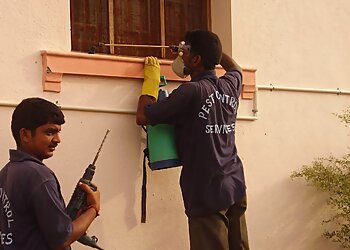Customized Pest Control Solutions Chicago: Tailored Program for Your Demands
Customized Pest Control Solutions Chicago: Tailored Program for Your Demands
Blog Article
A Comprehensive Guide to the Different Sorts Of Bug Control Methods
With the myriad of pest control techniques offered, it can be frustrating to locate the most reliable service for a particular pest trouble. In this comprehensive overview, we will certainly discover these various kinds of insect control approaches, offering understandings into their applications and advantages. By the end, you will have a more clear understanding of which approach may be the best fit for your bug control needs.
Chemical Insect Control Methods

One usual kind of chemical insect control is insecticides. Pesticides target specific insects, such as mosquitoes, termites, or ants, and can be used both indoors and outdoors.
An additional sort of chemical bug control is rodenticides. These are chemical compounds developed to regulate populaces of rats, such as rats and mice. Rodenticides are generally made use of in lure form, which draws in the rats and after that kills them after consumption. They are commonly utilized in farming settings, in addition to in property and commercial structures (Customized pest control solutions Chicago).
Weed killers, additionally recognized as herbicides, are an additional type of chemical pest control technique. Herbicides are developed to uniquely eliminate undesirable plants, known as weeds, without creating harm to desirable plants. They are frequently made use of in farming, landscape design, and horticulture to control the development of unwanted greenery.
While chemical insect control methods can be extremely effective in getting rid of bugs, it is very important to use them judiciously and comply with safety and security guidelines. Overuse or abuse of chemical pesticides can have adverse influences on human health and wellness and the setting. It is vital to employ these methods properly and consider different parasite control methods whenever possible.
Biological Parasite Control Methods
Organic bug control approaches entail making use of living organisms or natural compounds to manage and manage pest populations. Unlike chemical approaches, which often depend on synthetic pesticides, biological control approaches use the natural enemies of bugs to regulate their populaces. This approach is considered even more ecologically pleasant and lasting, as it minimizes making use of harmful chemicals and minimizes the danger of pesticide resistance.
One commonly utilized biological bug control method is the intro of natural killers or parasites. For example, ladybugs are introduced to control aphids, while certain wasp species are launched to target caterpillars. These predators and bloodsuckers prey on parasites, lowering their numbers and preventing infestations.
An additional organic control method is using virus. Particular germs, viruses, and fungi can be employed to contaminate and eliminate specific pests. The microorganism Bacillus thuringiensis is frequently made use of to control caterpillars, as it generates toxins that are lethal to these parasites.
Organic control approaches can also entail the use of scents or natural compounds that interrupt the breeding patterns of pests. By disrupting their recreation, these methods assist to lower pest populations with time.
While biological bug control methods are usually reliable, they may need longer durations to achieve preferred outcomes compared to chemical approaches. Additionally, cautious factor to consider must be provided to the option and release of natural adversaries to stop unintended injury to helpful organisms or ecosystems.
Physical Bug Control Methods
To properly handle and regulate pest populations, alternate bug control methods recognized as physical insect control approaches are utilized. Another physical parasite control technique is the installment of fences or wall surfaces to keep bigger parasites, such as deer or rabbits, out of yards or agricultural fields. Physical parasite control techniques are an ecologically friendly alternative to chemical pesticides, as they do not count on the use of unsafe chemicals.
All-natural Insect Control Techniques
Natural insect control approaches offer a sustainable and eco-friendly approach to managing and getting rid of pests. These methods webpage prioritize making use of all-natural substances and biological representatives, reducing the demand for chemical pesticides that can damage the environment and human health. One of the most common all-natural pest control approaches is biological control. This includes presenting natural predators or bloodsuckers to victimize or parasitize the insects. Ladybugs are frequently introduced to yards to regulate aphid populaces. One more natural technique is the usage of repellents obtained from plants. Particular plants, such as marigolds, lavender, and pepper mint, send out scents that repel bugs like mosquitoes, flies, and ants. Furthermore, cultural control methods can be utilized to stop why not try this out and manage bug problems. This consists of appropriate hygiene, routine upkeep, and promoting biodiversity in the garden. As an example, turning plants, eliminating yard debris, and encouraging natural predators can help avoid the buildup of pests. By embracing these natural insect control approaches, individuals and neighborhoods can successfully take care of parasites while decreasing the adverse influences on the setting and human health.
Integrated Parasite Administration (IPM)
Integrated Pest Management (IPM) is a detailed and organized method to pest control that combines various techniques and techniques to successfully manage bugs while decreasing making use of chemical pesticides. IPM intends to maintain pest populations listed below the financial injury degree by utilizing a mix of social, organic, and chemical control approaches.
Social control approaches involve modifying the environment to make it less positive for bugs. This can consist of techniques such as plant turning, correct hygiene, and making use of resistant plant selections. By developing negative problems for pests, social control approaches can significantly reduce pest populations.

Chemical control methods are used as a last resource in IPM. They include the targeted and sensible use of pesticides to take care of bug populations. Unlike standard bug control methods, IPM intends to decrease making use of chemical pesticides by employing different methods.
Integrated Pest Monitoring (IPM) is a positive strategy that concentrates on lasting insect monitoring instead of counting entirely on responsive steps. By integrating numerous control techniques, IPM provides a much more lasting and environmentally pleasant approach to pest control.
Final Thought
It went over chemical, organic, physical, and all-natural parasite control approaches, as well as the incorporated pest management method. By comprehending these different techniques, people can make educated decisions on which bug control technique is most appropriate for their details demands and choices.
Report this page